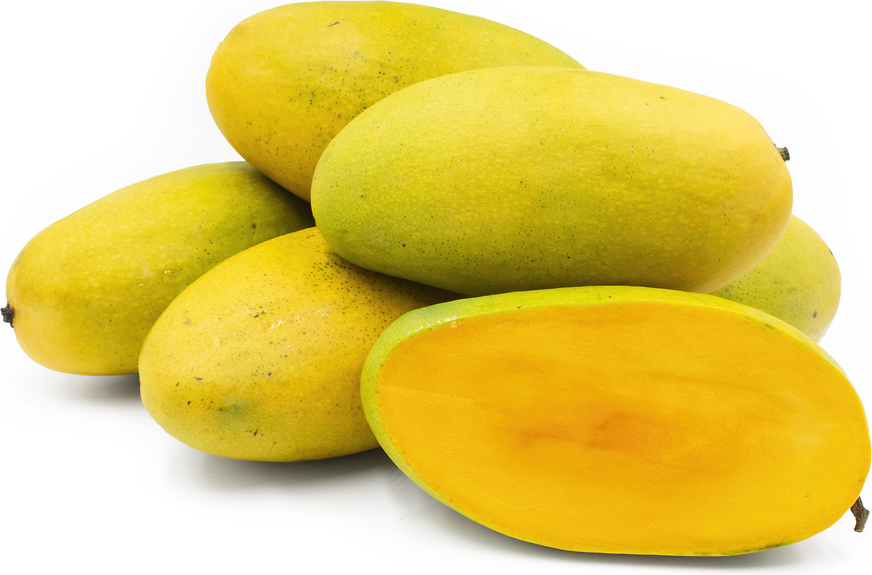


Dasheri Mangoes
Estimated Inventory, ea : 0
Description/Taste
Dasheri mangoes are small to medium-sized fruits, averaging 9 to 15 centimeters in length, and have an elongated, straight oval shape with blunt, curved ends. The skin is semi-thick, smooth, leathery, and subtly waxy, ranging in color from light green to yellow-green, transforming into a golden yellow hue when ripe. Underneath the surface, the orange flesh is tender, succulent, and almost entirely fibreless, encasing a moderately-sized stone. Dasheri mangoes are highly aromatic and bear a tropical, nectar-like scent. The fruit’s flesh is very sweet and contains tropical, fruity, and mildly tangy nuances.
Seasons/Availability
Dasheri mangoes are available in the summer.
Current Facts
Dasheri mangoes, botanically classified as Mangifera indica, are an Indian variety belonging to the Anacardiaceae family. The sweet fruits were discovered in the 18th century and are one of the oldest and most revered varieties in Northern India. Dasheri mangos are favored for their sweet flavor and juicy, smooth flesh and are a prized seasonal summer fruit utilized in raw and cooked preparations. There are several regional names for Dasheri mangoes, including Dusari, Dashehari, Dusehri, and Dussehri. Dasheri mangoes are also well-known throughout India for their role in breeding new mango varieties. The aromatic cultivar is the parent fruit to many mango varieties in Northern India, including mallika and amrapali, and was selected for its quality growth characteristics.
Nutritional Value
Dasheri mangoes, like other mango varieties, are an excellent source of vitamin C to strengthen the immune system and fiber to regulate the digestive tract. The fruits are also a good source of vitamin A to maintain healthy organ functioning, folate to assist in producing red blood cells, and other amounts of zinc, vitamin E, iron, and calcium. In addition to vitamins and minerals, Dasheri mangoes contain phytochemicals in the skin that may have antioxidant-like properties to reduce inflammation.
Applications
Dasheri mangoes have a sweet flavor and are considered “table” mangoes, meaning they are most often eaten fresh, out of hand. The fruits can be consumed as a healthy dessert or snack, simply sliced and served, or the flesh can be blended into juices, shakes, and smoothies. Dasheri mangoes can also be sprinkled with salt or chili powder, cut into salads, diced into salsa, or rolled in hand, squeezing the fruit to soften the pulp and poking a hole in the skin to release the juice. In addition to fresh preparations, Dasheri mangoes can be incorporated into desserts such as ice cream, sorbet, cake, and puddings, or they can be cooked into curry and served over steamed rice. In India, mangoes are popularly cooked, pureed, and boiled with spices and sugar to make kachcha aam papad. Once cooked, the mixture is left in the sun to dry and is later rolled or pressed into squares as a chewy snack. Mangoes are also blended into appekayi saru, a popular summer drink with coconut, spices, and peppers, or tok dal, another type of mango curry famous in Bengal. Dasheri mangoes pair well with meats such as beef, poultry, pork, and fish, coconut milk, aromatics including garlic, ginger, shallots, and chile peppers, and spices such as ginger, caraway seeds, cumin, turmeric, and curry leaves. Whole, unwashed Dasheri mangoes will ripen when stored at room temperature. Once ripe, the fruits can be stored in the refrigerator for up to one week. Sliced mangoes will keep several days when stored in a sealed container in the fridge.
Ethnic/Cultural Info
Malihabad is considered the mango capital of India and is home to some of the oldest mango trees in the country. The town was given a Geographical Indications, or GI, status by the government of India, which declares Malihabad to be the hometown of the Dasheri mango. The mother Dasheri tree is over 200 to 300 years old and resides in a grove near the Dasheri Village. Legend has it that there was an abandoned pile of mangoes in the village due to a tax dispute between mango growers. Left to rot, the fruits began to decompose, eventually sprouting the mother Dasheri mango tree. The mother tree was revered for its excellent flavor and texture and was eventually owned by the Nawab of Lucknow for personal consumption. The Nawab favored the mangoes so much that he hired guards to protect the tree day and night. He also had holes drilled into the seeds to prevent replanting, and the fruit was covered in nets on the trees to prevent birds from consuming the mangoes. It is unknown how the variety escaped this protection and was spread in cultivation throughout the region, but there are many whimsical tales and theories gladly shared among Malihabad residents. In the modern-day, the mother Dasheri mango tree is still heavily guarded, and each season, the fruits are sent to the Nawab’s living descendants.
Geography/History
Dasheri mangoes are native to a village near Malihabad within Lucknow, a district just south of the Nepal border in the state of Uttar Pradesh in Northern India. The mangoes were discovered growing as a chance seedling sometime during the 18th century and were heavily protected and guarded as a treasured variety. Dasheri mangoes eventually spread in cultivation and are grown throughout Northern India and Southern India in Andhra Pradesh. The mangoes are also cultivated in Pakistan and Nepal and are exported to Southeast Asia, including Hong King, Malaysia, the Philippines, and Singapore.
Recipe Ideas
Recipes that include Dasheri Mangoes. One
Podcasts




